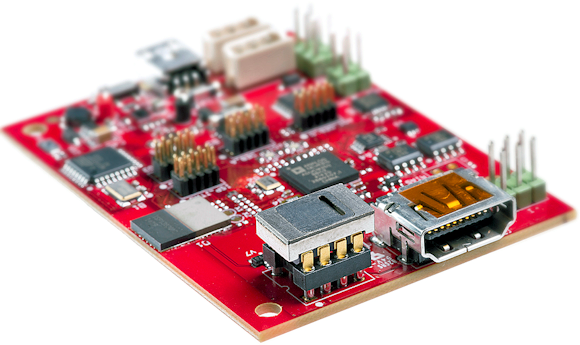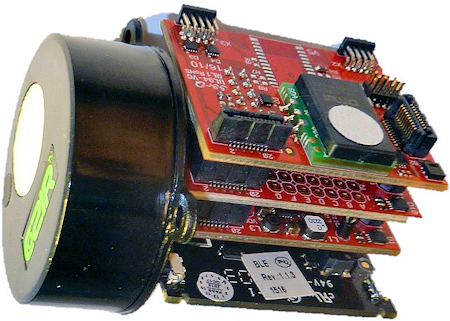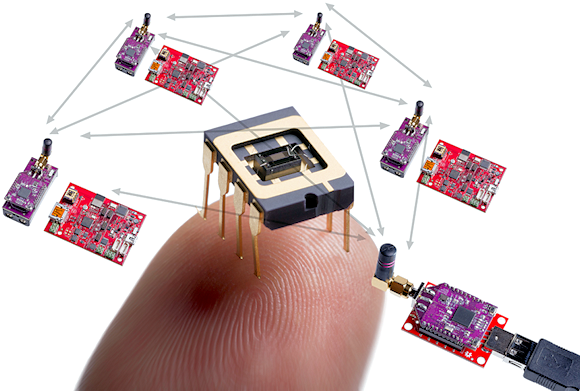
Getting Started
So you want to roll out a sensor network for measuring air quality, but aren't sure which sensors are most suitable? Or extend a home automation system with a sensor application, but aren't sure how to make the sensor communicate with the existing system? Additionally, how can you expand your sensor network with ever more sensors? To help solve these complex issues, a testbed can help companies find answers to these questions and build successful Internet of Things (IoT) applications
Texas Instruments' IoT readout board for the NO2 sensor
The IoT is on the rise. Ever more connected systems generate data and gather information about users and the world around us. In the future, these systems will not only take account of what their sensors tell them, but also of the world around them – by using data from the cloud. This way, the sensors build a holistic view of how their own data has been measured, and which actions have been taken.
We call this the Intuitive IoT, but making this concept a reality is very challenging. In order to build qualitative and reliable IoT applications, a few technical hurdles must first be cleared.
For example, today, an office environment typically contains two or three sensors. But what if this number increases to 100 or even 1,000 sensors in the years to come? How can we trace, maintain and charge the batteries of so many sensors? Additionally, how can we safely deal with the data they generate, or navigate the challenges of sensor nodes from different manufacturers communicating wirelessly with each other? Also, companies that develop services and applications are often insufficiently aware of the sensor landscape. Which sensors should they choose for their application and how can they keep the cost affordable?
A Testbed for Companies
Imec and Holst Centre have developed a testbed that can be used to easily try out and develop new IoT applications. With this testbed, users can test their sensors, communication radios, or ideas in order to accelerate the market introduction of their IoT application.
For example, a company specializing in home automation can evaluate which sensors are best to add to a home environment and how they can be implemented. The company could also use the testbed to try out their concept. The testbed itself consists of open source and commercial components and is easily configurable.
Next page
Testbed for City of Things
For one type of application, imec and Holst Centre have deployed a testbed for measuring air quality. Today very few commercial systems allow monitoring for air quality. In particular, systems that measure air quality in confined environments like an office building, a parking garage or a bedroom, where the air quality can vary greatly.
Using the testbed, a sensor network was developed that consists of 20 various commercial gas-sensing modules. The sensor network measures temperature, relative humidity, ambient light, CO2, NO2 and volatile organic compounds (VOCs). The data is sent to a gateway, which transmits them to the internet where they can be analyzed in real time.
A third generation of sensor modules has also been developed on the test bed. The sensor nodes have been built on top of a commercial board - Texas Instrument's SimpleLink multi-standard CC2650 SensorTag. The TI board contains standard sensors for temperature, relative humidity, ambient light and sound, an accelerometer, a gyroscope, a magnetometer, and a communication link via an 802.15.4 or Bluetooth Smart protocol.

Texas Instruments' IoT readout board for the NO2 sensor
Proprietary sensors were added for measuring gases such as CO2, VOC, NO2 and particles, and a passive infrared detector (PIR) for motion detection. It also contains a board that enables more efficient use of batteries. The hardware as well as the software architecture is component based, which allows the nodes to be extended with more sensors, different wireless protocols and even other operating systems.

Sensor module with third generation commercial gas sensors
Imec and Holst Centre added a few algorithms to the software of this system, such as those that enable data fusion. By measuring more than one type of gas and using a large number of gas sensors, users can look for correlations between data. This is more reliable than using just one sensor, and allows calibrating the system via the internet.
Gas sensors need re-calibration, especially when used in applications that require a lifetime of a few years. Many commercial sensors are not sensitive or drift in time, however, by applying data fusion, users can ignore intelligence from faulty sensors and generate data more accurately overall.
Essentially, companies can make use of this testbed, for example, to select the most suitable commercial gas sensor for their application. Standard algorithms can be used or new applications developed like the ability to couple gas measurements to air conditioning.
Next page
Localization Algorithms
The team at imec and Holst Centre is currently developing another sensor application utilizing the testbed: localization based on RF communication. Companies can make use of this solution to develop complete and scalable IoT applications.
The localization technique requires no satellites and can be used indoors as well. To make this possible, cheap standard radios that operate in the low-GHz domain are used with the addition of algorithms that allow tracking signals in the time domain. This makes it possible to measure when a signal is transmitted and received, and with which phase differences to determine the distance between transmitter and receiver.
Having a non-satellite version of a GPS system that can be used indoors is a very novel concept that allows tracing of all the sensors in a network. This can be very useful, in particular when the network contains hundreds or thousands of sensors. The ability to find and map all of these sensors is important for maintaining the network.
Localization can also be used to augment the safety of a sensor network. This prevents the smart sensors and actuators in a car or home from being manipulated remotely, for example, by asking for extra authentication. This can be enabled by adding distance-bounding protocols to the network's software. And, with software added to an existing solution, this is a cost-effective approach for companies.
Heterogeneous Networks
The testbed also allows investigating and testing other research topics, such as the communication between heterogeneous networks. In a network, sensor nodes can come from different manufacturers and work through different wireless protocols.
For example, if a user wants to install a smart thermostat that uses the thread network protocol, they may also need it to connect to their smart watch that uses Bluetooth Low Energy or a Wi-Fi protocol. In practice, they will need a gateway that translates one protocol into another in a very efficient way – without delay or loss of data packets. The testbed will enable any team to test and improve its solutions in a real situation.

Multi-sensor network
Ecosystem
By offering the testbed to companies, imec and Holst Centre aim to create a complete ecosystem on IoT applications. With the testbed and the technologies, the research organizations are able to offer complete IoT solutions, from sensor to cloud communication, that are reliable, intuitive and scalable.
About the Author
Kathleen Philips, Ph.D., is a program director at imec and Holst Centre for infrastructure and person-centric focused Perceptive Systems. She is responsible for program definition and execution of scientific and operational results. Holding various patents, Philips has authored and co-authored more than 60 papers. She is a graduate of the Katholieke Universiteit Leuven and Technische Universiteit Eindhoven where she earned a doctorate in philosophy and electrical engineering.
Related Stories
Global Demand to Skyrocket for IoT Devices -- Will Businesses Keep Up?
Internet of Things May Be Yesterday's Thing